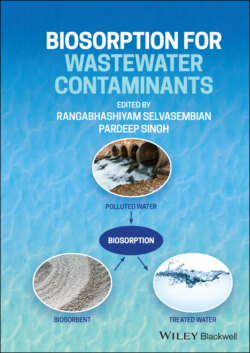Читать книгу Biosorption for Wastewater Contaminants - Группа авторов - Страница 37
Cost Evaluation
ОглавлениеApproximating the cost of biosorption and biosorbents is a challenging process that is rarely published. Cost assessment depends on many factors that make generalization difficult. Variables such as process handling, storage, energy use, repair, optimization of process, rejuvenation, discharge, and desorption are considered when evaluating cost. The type of water or effluent to be treated, as well as the amount, will affect the cost. Capital costs and operating costs, on the other hand, are determined by the type and size of the treatment plant.
It is preferred to employ wastes as a substrate for processing biosorbents in order to lower process expenses. Agricultural waste, home trash, and industrial waste, such as bacterial drainage from fermentation, fungal waste from food manufacturing, and waste from other industrial processes, can all be used to make biosorbents. Waste management is a significant environmental issue, and using these wastes addresses the concern while also lowering the cost of manufacturing biosorbents for treating water.
Pretreatment of feedstock is one aspect that increases production costs. Certain products need to be pretreated before manufacturing, and additional pretreatment increases the cost of production. It is important to note that feedstock treatment should be efficient but also inexpensive and accessible. It is critical that the treatment plant be placed near the effluent source in order to reduce expenses.
The cost of disposal must also be taken into account in biosorption, as once the biomass is fully used in repeated cycles it must be substituted. However, it may be applied in other areas, such as particulate board processing, cement, biogas, etc.
